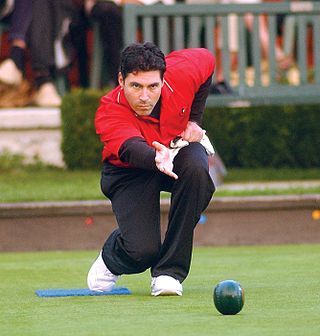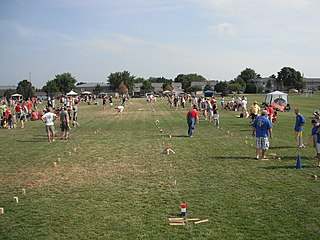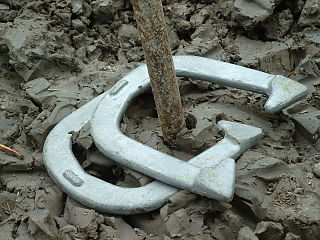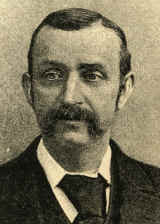
Bowls, also known as lawn bowls or lawn bowling, is a sport. Players try to roll their ball closest to a smaller ball. The bowls are heavier on one side so that they turn when being rolled. The game is played either in teams or one against one.

Kubb is a lawn game where the objective is to knock over wooden blocks by throwing wooden batons at them. Kubb can be described as a combination of bowling and horseshoes. Play takes place on a small rectangular playing field, known as a "pitch". "Kubbs" are placed at both ends of the pitch, and the "king", a larger wooden block, is placed in the middle of the pitch. Some rules vary from country to country and from region to region, but the ultimate objective of the game is to knock over the "kubbs" on the opposing side of the pitch, and then to knock over the "king", before the opponent does. Games can last from five minutes to well over an hour. The game can be played on a variety of surfaces such as grass, sand, concrete, snow, or even ice.

Five-pin bowling is a bowling variant which is played in Canada, where many bowling alleys offer it, either alone or in combination with ten-pin bowling. It was devised around 1909 by Thomas F. Ryan in Toronto, Ontario, at his Toronto Bowling Club, in response to customers who complained that the ten-pin game was too strenuous. He cut five tenpins down to about 75% of their size, and used hand-sized hard rubber balls, thus inventing the original version of five-pin bowling.

Ten-pin bowling is a type of bowling in which a bowler rolls a bowling ball down a wood or synthetic lane toward ten pins positioned evenly in four rows in an equilateral triangle. The objective is to knock down all ten pins on the first roll of the ball, or failing that, on the second roll. People approach modern ten-pin bowling as either a demanding precision sport or as a simple recreational pastime.

Skittles is a historical lawn game and target sport of European origin, from which the modern sport of nine-pin bowling is descended. In regions of the United Kingdom and Ireland the game remains as a popular indoor pub game.

Candlepin bowling is a variation of bowling that is played primarily in the Canadian Maritime provinces and the New England region of the United States. It is played with a handheld-sized ball and tall, narrow pins that resemble candles, hence the name.

Beer die, or snappa is a table-based drinking game in which opposing players sit or stand at opposite ends and throw a die over a certain height with the goal of either landing the die in their opponent's cup or having the die hit the table and bounce over the scoring area to the floor. The defending team attempts to catch the die one-handed after it hits the table, but before it touches a non-table surface. The game typically consists of two two-player teams with each of the four players having a designated cup on the table, but can also be played one-vs-one.

A baseball field, also called a ball field or baseball diamond, is the field upon which the game of baseball is played. The term can also be used as a metonym for a baseball park. The term sandlot is sometimes used, although this usually refers to less organized venues for activities like sandlot ball.

Horseshoes is a lawn game played between two people using four horseshoes and two throwing targets (stakes) set in a lawn or sandbox area. The game is played by the players alternating turns tossing horseshoes at stakes in the ground, which are traditionally placed 40 feet (12 m) apart. Modern games use a more stylized U-shaped bar, about twice the size of an actual horseshoe.

Table shuffleboard is a game in which players push metal-and-plastic weighted pucks down a long and smooth wooden table into a scoring area at the opposite end of the table. Shooting is performed with the hand directly, as opposed to deck shuffleboard's use of cue sticks.

Super Monkey Ball Deluxe is a platform video game developed by Tose and published by Sega. It was released for the PlayStation 2 and Xbox in 2005. The game compiles all stages from Super Monkey Ball and Super Monkey Ball 2, as well as adding original levels.
The following terms are used in water polo. Rules below reflect the latest FINA Water Polo Rules.

Five-pin billiards or simply five-pins or 5-pins, is today usually a carom billiards form of cue sport, though sometimes still played on a pocket table. In addition to the customary three balls of most carom games, it makes use of a set of five upright pins (skittles) arranged in a "+" pattern at the center of the table. The game is popular especially in Italy and Argentina, but also in some other parts of Latin America and Europe, with international, televised professional tournaments. It is sometimes referred to as Italian five-pins or Italian billiards, or as simply italiana. A variant of the game, goriziana or nine-pins, adds additional skittles to the formation. A related pocket game, with larger pins, is played in Scandinavia and is referred to in English as Danish pin billiards, with a Swedish variant that has some rules more similar to the Italian game.

Snooker is a cue sport that is played on a baize-covered snooker table with pockets in each of the four corners and in the middle of each of the long side cushions. It is played using a cue and snooker balls: one white cue ball, 15 red balls worth one point each, and six balls of different colours: yellow, green (3), brown (4), blue (5), pink (6), black (7). A player wins a frame of snooker by scoring more points than the opponent(s), using the cue ball to pot the red and coloured object balls. A player wins a match when they have achieved the best-of score from a pre-determined number of frames. The number of frames is always odd so as to prevent a tie or a draw.

Cornhole is a lawn game popular in North America in which players or teams take turns throwing fabric bean bags at an inclined board with a hole in its far end. The goal of the game is to score points by either landing a bag on the board or putting a bag through the hole.

Nine-pin bowling is a bowling game played primarily in Europe. European championships are held each year. In Europe overall, there are some 130,000 players. Nine-pin bowling lanes are mostly found in Austria, Czech Republic, Slovakia, Belgium, Germany, Luxembourg, the Netherlands, Estonia, Switzerland, Serbia, Slovenia, Croatia, Poland, North Macedonia, Hungary, France, Brazil and Liechtenstein.

Ladder toss is a lawn game played by throwing bolas onto a ladder.

The rules of water polo are the rules and regulations which cover the play, procedure, equipment and officiating of water polo. These rules are similar throughout the world, although slight variations do occur regionally and depending on the governing body. Governing bodies of water polo include FINA, the international governing organization for the rules; the NCAA, which govern the rules for collegiate matches in the United States; the NFHS, which govern the rules in high schools in the USA; and the IOC, which govern the rules at Olympic events.

Throwing sports, or throwing games, are physical, human competitions where the outcome is measured by a player's ability to throw an object.


















